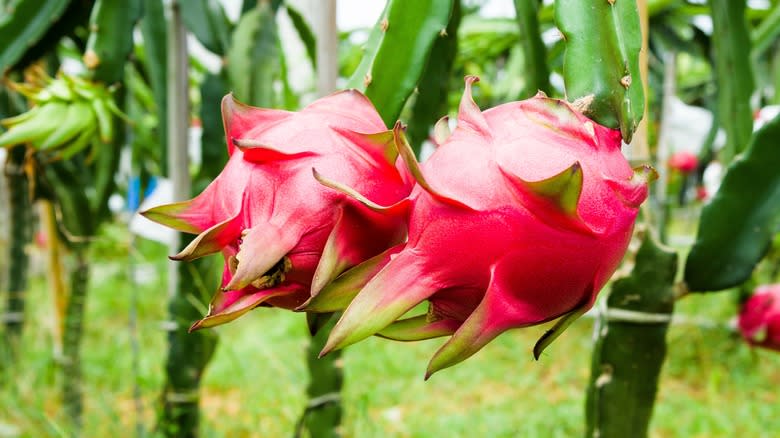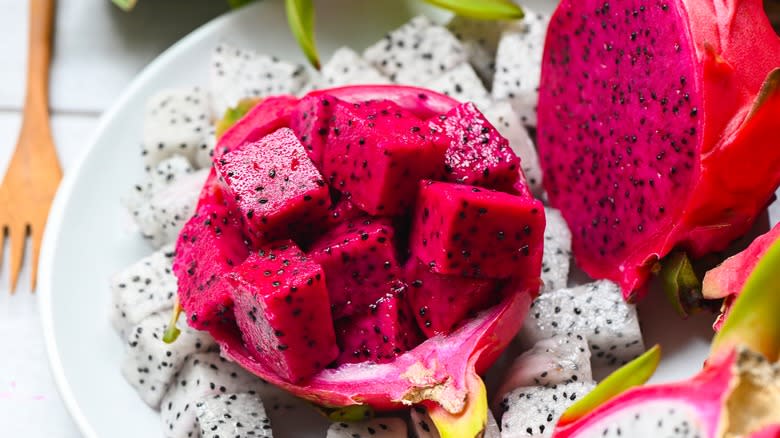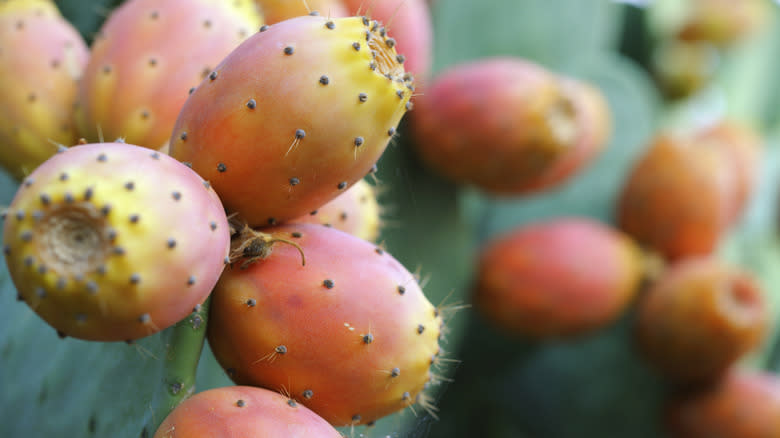The Big Differences Between Prickly Pear And Dragon Fruit

We live in a time when no matter where you live, fruits from around the world are more readily available than ever before. Sometimes, these fruits are not all that interesting to look at -- but other times, you'll find fruits that are incredibly visually striking. A stunning example can be found in the case of edible cactus fruits, which tend to be brightly colored and have textures unlike fruits that grow on a tree. Take, for example, dragon fruit, or even prickly pear. The two might look alike at first glance, but they're actually each unique in their own way.
Though the two fruits may be cousins, the differences are myriad: They don't taste the same, their outer shells are different, they're not quite from the same region, prickly pear seeds are hard to eat, and they're not the same size. The list could go on -- let's first take a look at what makes dragon fruit unique.
Read more: 12 Vegetables And Fruits That Used To Look Very Different
Dragon Fruit Has A Lot Of Striking Qualities

Dragon fruit (also known as pitaya or strawberry pear -- it's got a lot of names) may be the single most visually striking fruit in existence, both on the outside and inside. The outer shell of dragon fruit is eye-catching enough, with a bright reddish-pink (or sometimes yellow) shell with distinctive leaf-like green flaps. The inside can be even more vibrant, with pink or white flesh flecked with tiny, black, kiwi-like seeds. The skin itself is solid and thick enough to be used for other purposes (you can even turn it into a decorative and functional dessert bowl), while the interior flesh breaks down easily into smoothies.
A native plant of Central America (probably; historians aren't 100% sure), which now also grows heavily in Southeast Asia, dragon fruit is the product of a climbing cactus plant, meaning the plant doesn't have a spine and requires support. Ripe dragon fruit tastes like a very mild cross between a kiwi and a pear (while unripe dragon fruit doesn't really taste like anything), and has a slightly gritty texture owing to its seeds, which are easy to eat. They're also a decently-sized fruit, usually measuring about three inches in diameter.
Prickly Pear Has Surprisingly Little In Common With Dragon Fruit

Prickly pear, meanwhile, grows off a nopal cactus or paddle cactus, which are known for their leaves that look like paddles. While dragon fruit can be either deep pink-red or yellow, the prickly pear can be green, yellow, or red. Whereas dragon fruit has non-spiky flaps, prickly pear has the sort of tiny, sharp spines that we typically associate with cacti. Prickly pears are native to Mexico, and typically are about two to three inches in length, with larger fruits growing to about five inches in length. Prickly pear also tastes different from dragon fruit: while the latter has a milder flavor and a kiwi or pear-like taste, prickly pear is noticeably sweeter and tastes more like a strawberry or melon, with a slight tinge of bubblegum. The seeds are an even bigger difference: While dragon fruit seeds generally make for smooth eating, prickly pears have larger, thicker seeds that aren't much fun to chew.
The differences are vast, but the two fruits do share some similarities. Aside from both springing from cacti and offering a host of antioxidants and nutrients, there's one other main similarity between dragon fruit and prickly pear: they both function as natural laxatives, according to MedicineNet and EatingWell. So, if you were looking for a fruit that could keep you regular, well, you've found two of them.
Read the original article on Daily Meal.

